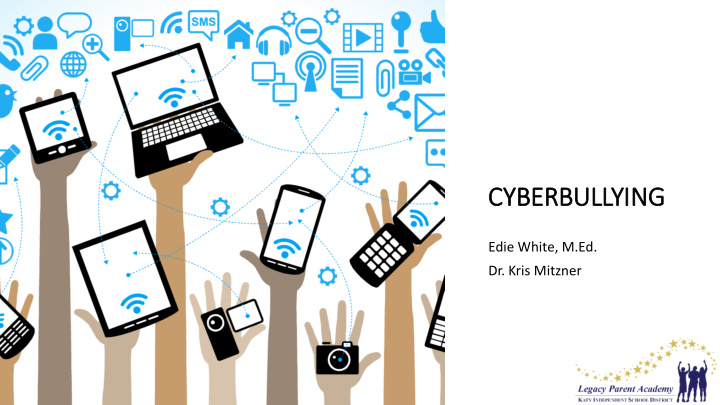



CYBERBULLYING Edie White, M.Ed. Dr. Kris Mitzner
MEDIA USE IS... “ Like the air they breathe, the water they drink and the food they eat.”
Significant changes as a result of SB 179: • The definition of bullying was broadened and now clearly includes cyberbullying • Increased campus jurisdiction in addressing incidents of bullying • Mandated a method for anonymous reporting SENATE BILL 179 • Earlier notification to parents of a bullied "David's Law" student • Expansion of DAEP placements or expulsions in severe cases • Injunctive relief • Criminal penalties
Cyberbullying is bullying that is done through the use of any electronic communication device, including through the use of a cellular or other type of telephone, a computer, a camera, electronic mail, instant messaging, text messaging, a social media application, an Internet website, or any other Internet-based communication tool.
KEY ISSUES SPECIFIC TO CYBERBULLYING
Words can spread faster than any infectious disease because of social media. AUDIENCE
PERMANENCE
ANONYMITY
ONLINE DISINHIBITION EFFECT
Exclusion Flaming Trickery Fraping Outing leaving someone out sending or posting befriending someone using someone's revealing sensitive or deliberately on social vulgar, abusive, or so he/she will share social networking personal information media, messages, or hostile messages personal information account or device to about someone email. intended to “inflame” with the intent of post inappropriate without his/her the emotions of outing. content with under consent for purposes others to incite an guise of his/her name of embarrassment or online "fight." humiliation. TYPES OF CYBERBULLYING
Dissing Masquerading Harassment Cyberstalking Happy-Slapping sustained and Recording someone spreading cruel assuming another continually constant pattern of being bullied or information about identity to harassing or dissing malicious messages harassed in a way someone through anonymously someone through using an electronic that usually involves public posts or cyberbully or harass posts or messages device or social physical abuse, then private messages to someone else. with threats of media with the posting the video damage his/her harm. intention of doing online for public reputation or harm. viewing. relationships with other people. TYPES OF CYBERBULLYING
STATISTICS • 59% of U.S. teens have been bullied or harassed online, and over 63% believe it's a major problem for people their age. • The percentages of individuals who have experienced cyberbullying at some point in their lifetimes have nearly doubled (18% to 34%) from 2007-2016. • 67% of teens who are online almost constantly have been cyberbullied, compared with 53% of those who use the internet several times a day or less. • 23% of students who reported being cyberbullied notified an adult at school about the incident. • 90% of teens who report being cyberbullied have also been bullied offline. • 160,000 kids per day skip school for fear of being bullied.
• Most elementary students experience cyberbullying while playing online games. • Face-to-face bullying is more common in elementary school than cyberbullying, but CYBERBULLYING progressively increases at each grade level. • Anonymity in cyberbullying is more common in AND AGE elementary school. • Among high school students, 15.5% are cyberbullied.
• In a 2017 study conducted by the U.S. Department of Education, three times as many girls reported being harassed online or by text message than boys. • The types of cyberbullying differ between genders; Girls report a higher rate of name calling and being the target of false rumors and GENDER AND boys report higher rates of receiving online CYBERBULLYING threats. • Girls are more likely than boys to be both targets and cyberbully others. 15% of teen girls have been the target of at least four different kinds of abusive online behaviors, compared with 6% of boys.
• Becomes upset, sad or angry during or after being online or using his/her phone • Withdrawal from family or friends • Sudden change in friends • Uneasy or unwilling to attend school • Indirect comments about bullying • Change in device usage • Reluctance to let parents near device • Unwilling to discuss or share information about online accounts and activity • Somatic symptoms
FEELINGS OF HUMILIATION, INCREASED ABSENTEEISM EMBARRASSMENT, EMOTIONAL OR SHAME DISTRESS EFFECTS OF CYBERBULLYING DECLINE IN LOW SELF- SOCIAL ANXIETY ACADEMIC ESTEEM PERFORMANCE
LEGAL ISSUES TEXAS PENAL CODE § 42.07- TEXAS PENAL CODE § 33.07- HARASSMENT ONLINE IMPERSONATION
FREEDOM OF SPEECH • We have a right to free speech, but legislation creates boundaries. • Tinker test: • Did the cyberbullying cause a substantial interference in the school? OR • Could a substantial interference be reasonably forecasted? • Did the speech interfere with or deny rights of others? This Photo by Unknown author is licensed under CC BY-SA.
IMPACT OF CYBERBULLYING AT SCHOOLS A campus administrators' perspective
Establish open lines of communication and trust Electronic Device Contract TIPS FOR Learn how social networking sites and apps work PARENTS Stay involved in your child's cyber-world Talk about cyberbullying and what to do
RESPONDING TO CYBERBULLYING Do not engage with the person(s) cyberbullying. Block the person(s) on all social media accounts and change privacy settings to private. Save the messages or posts. Tell a trusted adult.
Policies on bullying and cyberbullying Mandatory Trainings Professional development for all administrators SpeakUP National Bullying Prevention Month HOW KATY ISD IS ADDRESSING Digital citizenship lessons CYBERBULLYING? Student survey Bullying Prevention Parent Advisory Council School counseling offered Parent workshops and resources
ANY QUESTIONS?
RESOURCES • https://cyberbullying.org/2019-cyberbullying-data • https://www.pacer.org/bullying/resources/stats.asp • http://www.bullyingstatistics.org/content/bullying-and-suicide.html • https://www.pewinternet.org/2018/09/27/a-majority-of-teens-have-experienced-some-form-of- cyberbullying/ • http://www.bullyingstatistics.org/content/cyber-bullying-statistics.html • https://meganmeierfoundation.org/statistics • https://www.dosomething.org/us/facts/11-facts-about-cyber-bullying#fnref11 • https://yth.org/wp-content/uploads/Cyberbullying-Second-Draft-10-5.compressed.pdf • https://www.bullying.co.uk/cyberbullying/effects-of-cyberbullying/
Recommend
More recommend